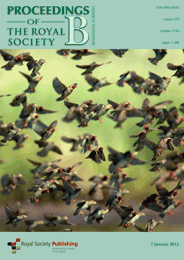
墨累澳龟没有破壳而出时,似乎能够感知其他兄弟姐妹们的进度。这样这些龟就可以改变自己的步调,让大家进度达到一致,一起出壳。
墨累澳龟( Emydura macquarii)在埋在沙子下头的蛋里,没有破壳而出时,已经可以和兄弟姐妹们商量什么时候出来了。
尽管蛋总是在同一时间生在一个地方,但是上层靠近太阳晒热土壤的蛋比下层较冷土壤处的蛋要发育得快。对此,这种龟似乎能够感知其他龟的进度,从而改变自己的步调,让大家步调达到一致。
澳大利亚西悉尼大学的斯潘塞(Ricky-John Spencer)已经对这种龟做了多年的研究。2003年时他收集了很多野外的龟蛋,将这些蛋分成两组并在25℃或30℃下孵化。之后他将这些蛋放回一起,斯潘塞发现这些蛋还是会在同一时间一起孵出小龟。
之后斯潘塞继续对这个现象进行了研究。研究小组让怀孕的墨累澳龟在实验室环境中生蛋。他们将每堆蛋分两组,一组温度26℃,一组温度30℃。经过约一周的发育后放回到一起。研究者接下来通过心率和二氧化碳排放来监控每一个胚胎的新陈代谢。此外,作为对照组,还有一些蛋也被分为两组,然后都放在26℃的环境中,然后再放回到一起。
11月30日发表于《皇家学会学报B》(Proceedings of the Royal Society B)上的这个论文发现,如果胚胎和其他发育更快的同类放在一起,它们就会提高自己的发育速度。在接下来的时间中,它们的心率会提升,并排出比对照组多67%的二氧化碳。
研究小组认为,胚胎在蛋里时肯定能够互相“沟通”,但目前还不清楚它们是怎么做到的。科学家觉得,或许是窝中的变化触发了特定的荷尔蒙改变了海龟的新陈代谢。当氧气水平下降时胚胎会产生更多的甲状腺激素。而生长迅速的胚胎会大量消耗周围的氧,并排出更多二氧化碳。氧气的减少可能会使得发育慢的胚胎产生更多的甲状腺激素并加速生长。

 Embryonic communication in the nest: metabolic responses of reptilian embryos to developmental rates of siblings
Embryonic communication in the nest: metabolic responses of reptilian embryos to developmental rates of siblings
Jessica K. McGlashan, Ricky-John Spencer and Julie M. Old
Incubation temperature affects developmental rates and defines many phenotypes and fitness characteristics of reptilian embryos. In turtles, eggs are deposited in layers within the nest, such that thermal gradients create independent developmental conditions for each egg. Despite differences in developmental rate, several studies have revealed unexpected synchronicity in hatching, however, the mechanisms through which synchrony are achieved may be different between species. Here, we examine the phenomenon of synchronous hatching in turtles by assessing proximate mechanisms in an Australian freshwater turtle (Emydura macquarii). We tested whether embryos hatch prematurely or developmentally compensate in response to more advanced embryos in a clutch. We established developmental asynchrony within a clutch of turtle eggs and assessed both metabolic and heart rates throughout incubation in constant and fluctuating temperatures. Turtles appeared to hatch at similar developmental stages, with less-developed embryos in experimental groups responding to the presence of more developed eggs in a clutch by increasing both metabolic and heart rates. Early hatching did not appear to reduce neuromuscular ability at hatching. These results support developmental adjustment mechanisms of the ‘catch-up hypothesis’ for synchronous hatching in E. macquarii and implies some level of embryo–embryo communication. The group environment of a nest strongly supports the development of adaptive communication mechanisms between siblings and the evolution of environmentally cued hatching.
文献链接:https://rspb.royalsocietypublishing.org/content/early/2011/11/24/rspb.2011.2074







